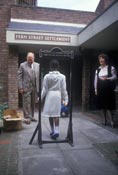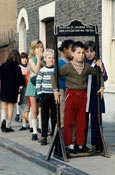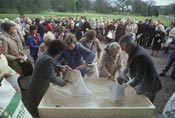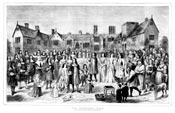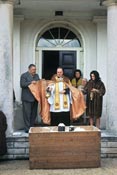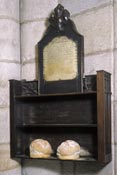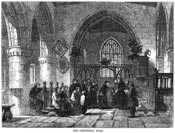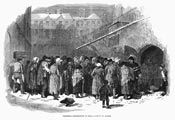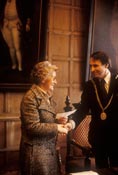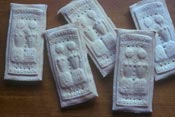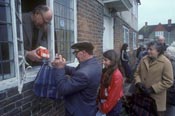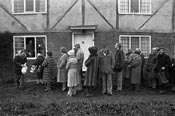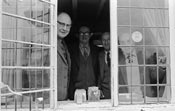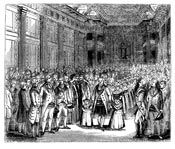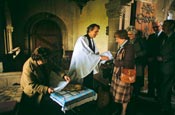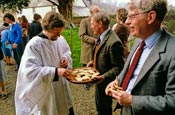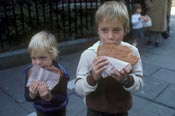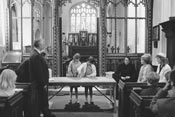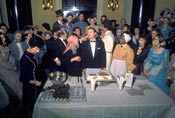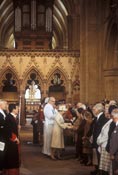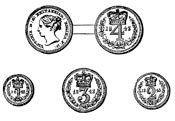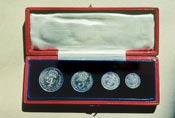
There must be hundreds of doles around Britain, given out without ceremony, because trustees are bound to according to charity laws. If the funds run out or become too trivial, or the specified recipients can’t be found (such as servants, ‘deserving poor’ or deprived kids in Fern Street) no alteration of the original terms of the bequest can be made without reference to the Charity Commissioners. If they are made the usual solution is to combine several trusts into something worthwhile. However some live on because of their extreme quirkiness, others because the dole is well worthwhile, a few because of both.
Farthing Bundles were invented in 1907 soon after the Fern Street Settlement was established in Bromley-by-Bow, East London. Clara Grant wanted to bring some relief to the poor of the area and one of her inspired ideas was to offer a little package each Saturday morning to their children small enough to pass under a four foot arch. She was not going to give the bundles away, though, and made them pay a farthing, the smallest coin of the realm. Literally hundreds turned up so that soon it was boys one week girls the next, and this went on for fifty years, until WW2 and the welfare state changed everything. Even the arch had to be raised regularly because children became bigger. Farthing Bundles were more or less gone by the early eighties. What could you fill them with for a penny? What child was going to turn out for anything that cost less than £5 then, £50 now. They still do it on very special occasions, but it died out for the best reasons. Tichborne Dole, on the other hand, thrives because the tradition has become so famous and the handout of a gallon of flour for each adult from the parishes of Tichborne and Cheritons and half that for each child, is well worthwhile. However the flour is supposed to be derived from a particular piece of land, which cannot produce nearly enough flour for the hundreds who turn up. Each March the family in Tichborne House have to shell out substantial sums for several sackfuls. Another reason might be the curse of Lady Mabella Tichborne who swore on her deathbed in 1150 that if they didn’t do it the consequences for the family and their house will be catastrophic!
Some doles are daily or weekly. The Hospital of St Cross, near Winchester, offers a ‘Wayfarer’s Dole of bread and a fifth of a pint of beer to anyone who drops in and asks. Carmel Priory provides bread every Sunday – but it is seldom taken. Sherborne Dole has a charming feudal air as the villagers line up at the (back) gate of the Castle on Christmas morning to receive their 10p from the Digby currently in residence. The Digby family have been there since 1617. In Guildford ‘Dicing for the Maid’s Money’ has a different problem because sometimes they can’t find any maids, domestic servants being more or less a thing of the past. No problems with Biddenden Dole though, except that scholars have been arguing about the founders of the dole for the last 879 years, even if the actual distribution of bread, cheese and tea continues unabated every Easter Monday. Eliza and Mary Chulkhurst were conjoined twins born in Biddenden, Kent, in 1100. They lived for 34 years, until Mary died, followed by Eliza six hours later. Almost every detail of this excellent story has been challenged, even their name, but there is no doubt that somebody bequeathed the land to provide for this thriving charity and that the village has been dining out on the Biddenden Maids for centuries. The Freemasons’ Orphans are on parade so that the grown-up Freemasons will be reassured that the charity they provide is being well used. Pax Cakes are distributed on Palm Sunday in some churches in Herefordshire. They are really biscuits with ‘Peace and Good Neighbourhood’ stamped on them, and that is what they are about. ‘Tuppenny Starvers’, less holy but much more edible, are distributed after a children’s service on the Tuesday after Easter according to the benevolent bequest of Peter and Mary Davis in 1748. In St Briavels they throw pieces of Bread and Cheese to parishioners after Whit Sunday evensong which, for some reason, perpetuates the rights of the people who do it to gather wood in their part of the Forest of Dean. George Carlow of Woodbridge left instructions in his will to give twenty shillings worth of bread to the poor ‘on the 2 day of February for ever.’ That must have been a substantial pile of bread in 1738 when he died but by the end of the 20th century not only had the bread dwindled to a few buns but ‘the poor’ had vanished altogether. The capital has been added to other Woodbridge charities but the ceremony is no more. On the Tuesday after Easter twelve children are still ‘Dicing for Bibles’ in St Ives, Cambridgeshire, according to the bequest of Dr Robert Wilde in 1675. After buying six bibles there used to be a dinner for the vicar and churchwardens ‘with as much claret and sack as the remaining money will provide’. Alas, this part of the ceremony lapsed long ago. The Baddeley Cake is still cut in the green room of the Theatre Royal, Drury Lane, with predictable theatrical bezazz by the cast, in costume and makeup, after the show current on Twelfth Night, according to the will of actor Robert Baddeley in 1794. The 18th century poet and cleric, Stephen Duck of Charlton in Wiltshire, left funds to pay for an annual reading of his poems at a ‘Duck Feast’ at the ‘Charlton Cat’. The ‘Pretty Maid’ is presented to the people of Holsworthy at 12 o’clock on the first morning of St Peter’s Fair according to the will of Rev Thomas Meyrick who died in 1841. A small sum was to be paid annually ‘to the young single woman... who is generally esteemed...as the most deserving, the most handsome, and the most noted for her quietness and attendance at church’. The Pretty Maid has developed into something of a celebrity in town – though officials mutter darkly that some years it is difficult to find anyone suitably qualified!
The Royal Maundy distribution is paid for by the Royal Almonry. The ceremony commemorates Jesus washing the feet of the Disciples after the Last Supper and had evolved to recognisable form with King John in the 13th century, since when it has continued to evolve, up to the present day. The Maundy Service has had many homes over the centuries, most notably Westminster Abbey, but the present Queen has preferred to take it around the country to a different cathedral each year, using the Abbey only at ten year intervals. She distributes two leather purses to worthy though not necessarily poor pensioners, men and women in equal numbers corresponding to her own age. The red purse contains a token sum of real money, in lieu of the clothes and provisions provided in earlier times, the white one the specially minted Maundy Money, four coins of face value 1,2,3 and 4 pence. It is a spectacular service, preceded by a procession of over a hundred characters including the Queen, naturally, Royal staff from the Lord High Almoner to the Yeomen of the Guard, Cathedral officials from the Bishop to the choir. However if you want to get in yourself you will have to be invited as a worthy ‘Recipient’, or at least a big noise in the diocese - or a string-pulling photographer!

